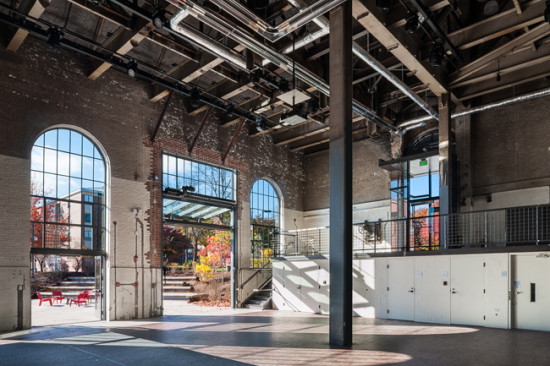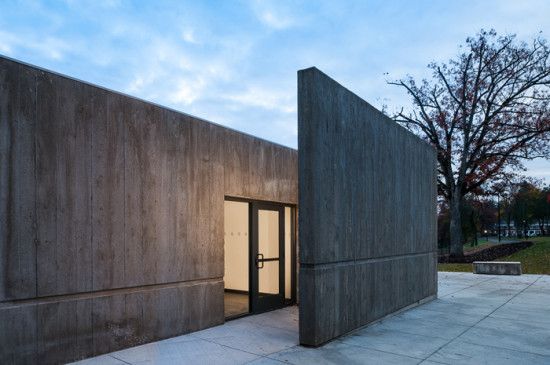
Renovation transforms decommissioned McKim Mead & White building into campus event space.
When Amherst College decided to convert a former steam plant into a student event space, the choice likely struck some observers as odd. Designed in 1925 by McKim, Mead & White, the coal-burning plant was decommissioned in the 1960s; since the 1980s, it had been used as a makeshift garage for ground equipment. The facade of the neglected building needed to be opened up to reveal its potential while respecting its good bones. “It wasn’t in great shape, but it wasn’t in terrible shape,” said Bruner/Cott‘s Dana Kelly. “Impressively enough, the school recognized that it had qualities that could be harnessed for a new student space.” The brick building’s industrial aesthetic was a particular draw, said Kelly, whose firm has spearheaded renovations at the nearby MASS MoCA (itself a former industrial complex) since the museum opened in 1999. For Amherst College, Bruner/Cott took a similar approach, balancing preservation and alteration to support the new program without disrupting the historic building’s essential character.

By the time Bruner/Cott began work on the Powerhouse, the original brick envelope had already seen a lot of change. Earlier renovators had filled windows with glass block, rebuilt a blind arch in mismatching brick, and cut a large garage door into the south facade. “Since the building had been altered so much, we chose to continue the dialogue by restoring or reconstructing some exterior elements, and sensitively altering others to match the new use and open the building up to campus,” said Bruner/Cott’s Jason Forney and Aoife Morris. On the side of the building facing the campus road, the architects inserted a new steel and glass entrance into a blind brick arch. On the south facade, to connect the interior to the new outdoor terrace, they inserted historic replica windows and french doors in place of the glass block, and swapped out the roll-up garage door for a bi-fold glass door. On the north side, which faces the parking lot, Bruner/Cott retained the existing glass block. “The observer still reads the McKim, Mead & White design, but with the changes the building has evolved to be an extroverted part of campus instead of being an introverted coal-burning steam plant,” said Forney and Morris.

- Facade Manufacturer
Universal Window & Door (glazing), OldCastle (entrances), Vermont Structural Slate (roofing) - Architects
Bruner/Cott - Facade Installer
Waterman Excavating, Inc. - Location
Amherst, MA - Date of Completion
2014 - System
renovated brick shell with new glazing, doors, and slate roof, board-formed concrete addition - Products
Universal glazing, OldCastle entrances, Vermont Structural Slate roofing, Wilson Doors overhead bi-fold door, Stiles and Hart waterstruck brick, custom sign from Roll Barresi & Associates
Environmental performance was a priority for the architects, who will monitor the building’s energy consumption during occupancy. They talked Amherst College into opting for operable windows over mechanical cooling. For heat, they chose a hydronic radiant floor and an overhead infrared heater that runs on gas. “These systems work to heat the bodies of occupants, instead of heating the large volume of air in the space,” explained Forney and Morris. An insulated chamber designed by Bruner/Cott captures waste heat from the new steam plant below the building and releases it into the event space during the winter. The architects chose not to insulate the interior walls “since their character was an important design element for the event space,” said Forney and Morris. To compensate, they installed a new slate roof, heavily insulated with spray-on cellulose. The new roof, noted Forney and Morris, mixes two colors of stone “to achieve the mottled effect of the existing roof, which was beautiful but had outlived its lifespan.”
To avoid interrupting the Powerhouse’s open plan, Bruner/Cott situated the restrooms in an understated addition constructed from board-formed concrete. “We find that additions like this are often necessary to support existing buildings without undermining their spatial qualities,” observed Forney and Morris. To foreground the steam plant itself, “we chose to make the addition appear like a garden wall—a ‘non-building,'” they said. “It is simply two offset concrete walls that conceal the door to the terrace.” The contractor built the formwork from rough-hewn lumber to achieve a patinated look, and tinted the concrete to match the existing water table banding. The addition’s gutters are designed to pour water down the face of the wall and hasten the appearance of age.
Like Bruner/Cott’s sensitive renovation, the steam plant’s new moniker—the Powerhouse—effectively gestures at both the history of the building and its new incarnation as a campus activities hub. “Amherst College chose the name both to remind students of the building’s industrial past, and to recognize its place in 21st-century student life,” said Forney and Morris. Once responsible for producing heat, today the structure generates something less material, but equally important: student engagement.





